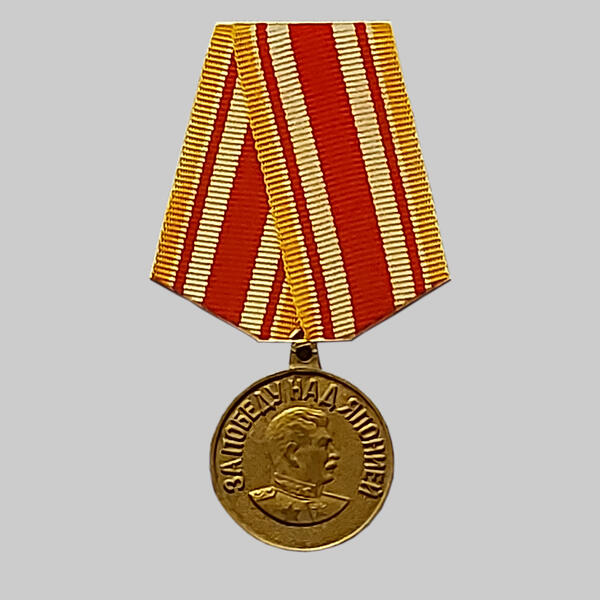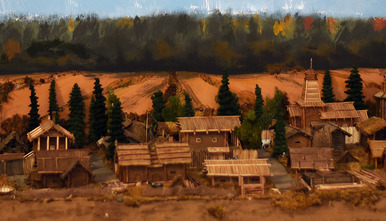A decree of the Presidium of the Supreme Soviet of the USSR dated September 30, 1945 established the medal ‘For the Victory over Japan’ to the award the participants of the Soviet-Japanese War in August-September 1945, during which a million strong Kwantung Army was completely defeated. According to Soviet data, its losses amounted to 84 thousand people, taken prisoner about 600 thousand. In this war 12 thousand Soviet soldiers died. Soviet troops occupied ManchUria, the Kuril Islands and South Sakhalin.
The main combat on the continent lasted 12 days, until 20 August. However, sporadic fighting continued until 10 September, which was the day of the complete surrender of the Kwantung Army. Soviet troops remained in north-eastern China until May 1946. The fighting on the islands ended completely on 5 September 1945. The official end of the war between the USSR and Japan took place on 12 December 1956, the day of the entry into force of the 1956 Moscow Declaration. The peace treaty between Japan and Russia (the successor to the Soviet Union) has not yet been signed.
Four draft medals were presented to be established. The project by artist M.Lukina was chosen. The medal ‘For Victory over Japan’ in the form of a correct circle with a diameter of 32 mm was made of brass. On the front of the medal is a profiled chest-high image of the Generalissimo of the Soviet Union, Joseph Stalin, with the commander’s face turned to the right. At the top of the medal you can read the inscription “For victory over Japan”. All the inscriptions and images on the medals are convex.
The medal “For the Victory over Japan” was awarded to all soldiers and other persons who served in the ranks of the Red Army, Navy and People’s Commissariat for Internal Affairs (NKVD) troops. They were required to take direct part in combat operations against the Japanese forces as part of the 1st Far East, 2nd Far East and Zabaikal Fronts, the Pacific Fleet and the Amur River Flotilla.
Medal ‘For the Victory over Japan’ was worn on the left side of the chest and if there were other medals of the USSR it was placed after the medal jubilee medal ‘Forty Years of Victory in the Great Patriotic War 1941-1945’. Those who were awarded the medal ‘For the Victory over Japan’, were subsequently awarded jubilee medals in memory of the victory in the Great Patriotic War of 1941-1945. The total number of winners of the medal ‘For Victory over Japan’ is more than 1 million 800 thousand people. Despite the fact that the status of the medal provided for a one-time award, there have been cases of re-awards.
The main combat on the continent lasted 12 days, until 20 August. However, sporadic fighting continued until 10 September, which was the day of the complete surrender of the Kwantung Army. Soviet troops remained in north-eastern China until May 1946. The fighting on the islands ended completely on 5 September 1945. The official end of the war between the USSR and Japan took place on 12 December 1956, the day of the entry into force of the 1956 Moscow Declaration. The peace treaty between Japan and Russia (the successor to the Soviet Union) has not yet been signed.
Four draft medals were presented to be established. The project by artist M.Lukina was chosen. The medal ‘For Victory over Japan’ in the form of a correct circle with a diameter of 32 mm was made of brass. On the front of the medal is a profiled chest-high image of the Generalissimo of the Soviet Union, Joseph Stalin, with the commander’s face turned to the right. At the top of the medal you can read the inscription “For victory over Japan”. All the inscriptions and images on the medals are convex.
The medal “For the Victory over Japan” was awarded to all soldiers and other persons who served in the ranks of the Red Army, Navy and People’s Commissariat for Internal Affairs (NKVD) troops. They were required to take direct part in combat operations against the Japanese forces as part of the 1st Far East, 2nd Far East and Zabaikal Fronts, the Pacific Fleet and the Amur River Flotilla.
Medal ‘For the Victory over Japan’ was worn on the left side of the chest and if there were other medals of the USSR it was placed after the medal jubilee medal ‘Forty Years of Victory in the Great Patriotic War 1941-1945’. Those who were awarded the medal ‘For the Victory over Japan’, were subsequently awarded jubilee medals in memory of the victory in the Great Patriotic War of 1941-1945. The total number of winners of the medal ‘For Victory over Japan’ is more than 1 million 800 thousand people. Despite the fact that the status of the medal provided for a one-time award, there have been cases of re-awards.



